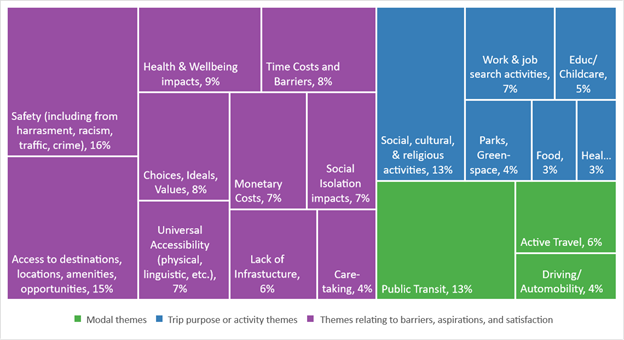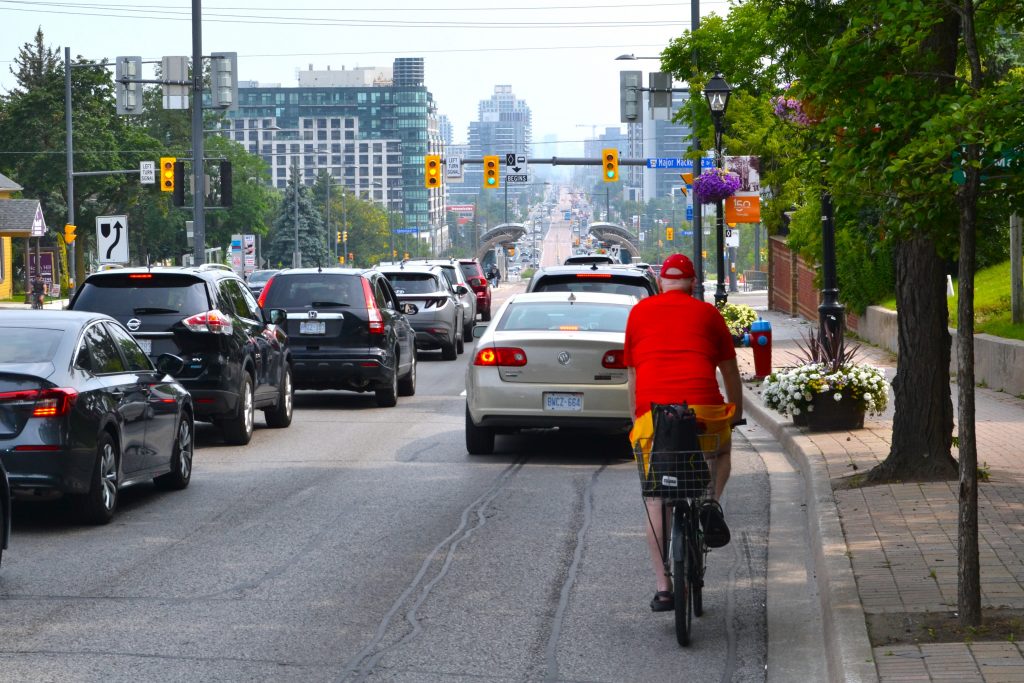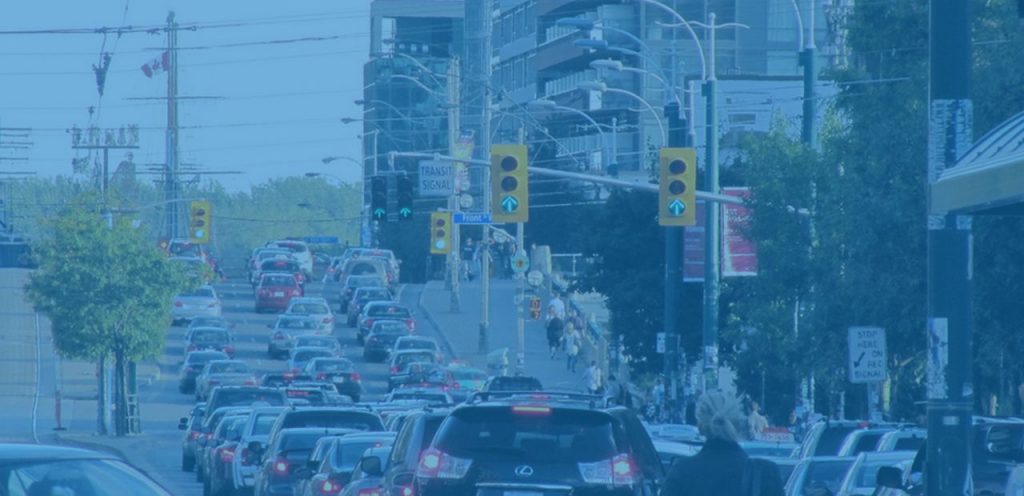Designing the first national survey on transportation equity in Canada
Hello, my name is Hedieh Keshavarz and I work as a member of the National Survey group within the Mobilizing Justice Partnership. I am a master’s degree student at Polytechnique Montréal under supervision of Professor Catherine Morency, the National survey working group academic lead. Howaida Hassan from the City of Edmonton is the partner lead for National Survey. The objective of this collaboration is to design the first national survey on transportation equity and transportation related social exclusion in Canadian cities. In this blog a summary of steps taken to design the national survey is provided.
Why a National Survey on transportation equity?
Traditional transportation surveys gather data on individuals’ mobility behaviour around cities. This data includes the choice of mode of transportation and travel times to destinations. These data are then used by transport planners to make decisions about future infrastructure investments and to study how these investments can affect people’ s mobility patterns. What traditional surveys cannot capture are the challenges people face in their daily travel, the barriers that stop them from traveling the way they desire, the trade-offs they make to afford transportation or to be on-time, the trips they miss or the ones they have to make against their wishes, and how all of these impact individual’s well-being. In this regard, the National Survey team aims to design the first national survey on transportation poverty and transportation related social exclusion which is capable of measuring all of these latent elements to make future urban planning more equitable.
What steps to take?
- Workshop on national survey
- Community Equity Advisory Table (CEAT) formation
- Survey CEAT
- Meet CEAT and exchange ideas
- Create a pool of all potential questions
- Develop different scenarios to be tested in pilot surveys
National workshop
As the very first step, an online workshop of 70 stakeholders was held to brainstorm and discuss the main elements to be included in the survey. The workshop covered the discussion related to potential elements associated with mobility aspirations, barriers & constraints, social, economic, & wellbeing outcomes, mobility satisfaction, and suppressed & unwanted travel to be included in the survey. Each subject was discussed in separate breakout room sessions which led to an extensive workshop report. The following table provides a summary of all elements that have the potential to be included in the final survey.
| Theme | Potential elements to be asked |
| Mobility aspiration | Aspirations for where to live; Aspirations for access to destinations; Aspiration for public transit; Active travel aspirations; Vehicle ownership aspirations; Person-specific aspirations; Quality of life aspirations |
| Barriers and constraints | Social and institutional barriers; Digital and transactional barriers; Safety barriers; Design and active travel barriers; Public transit barriers; General and multimodal barriers |
| Social, economic, and well-being outcomes | Employment and educational outcomes; Well-being outcomes; Participation outcomes; Social connections; Health outcomes; Financial outcomes; General well-being outcomes |
| Mobility satisfaction | Satisfaction with functional ability of travel to meet needs; Satisfaction with experiential components of travel; Mode-specific satisfaction; Satisfaction with built environment and access; Emotional and psychological satisfaction |
| Suppressed and excess travel | Suppressed essential activities; Missed work or school; Suppressed physical/outdoor activities; Missed social/cultural/civic activities; Missed children’s activities; General characteristics and causes |
Discussions made at the workshop informed the national survey team about data requirements and points of interest of Mobilizing Justice project partners and stakeholders. A very important recommendation was to develop an equitable co-creation process and engagement plan, which led to the establishment of a Community Equity Advisory Table.

Community and Equity Advisory Table (CEAT)
The CEAT is a committee of 20 community leaders, advocates and service providers from across Canada with lived expertise on different topics impacting equity deserving communities. So far, the CEAT has worked with the National Survey group on our scope of work, survey question selection, and recruitment processes.
CEAT members were invited to a meeting so that we could learn from their knowledge and expertise. Prior to this meeting, a draft questionnaire with suggestions for survey elements and potential question themes was sent to CEAT members. The questionnaire was designed based on the workshop results, while first section was about topics which CEAT thought were essential to include in the survey. The second section included evaluating proposed questions in four categories, namely, home location, access to destinations, mobility services and infrastructure, mode choice & mobility behaviour, and finally a third section on survey design components. The written feedback provided by the CEAT helped shape our meeting with CEAT.
CEAT members’ meetings provided new insights into the survey’s design, how questions should be worded to be coherent to all, and what can be vague and should be avoided. Key insights included:
- “Home location” is vague and it is wise to use the term “dwelling” when asking about attributes of the place people live in and the term “neighbourhood” when asking about what is around people and what they have access to.
- When asking about safety we should clearly define whether we are asking about safety of the mode of transport or the built environment. Moreover, safety from crime, harassment, profiling, traffic, etc., needs to be clearly defined to avoid any confusion among respondents.
- The concepts of “suppressed and unwanted travel” should be clearly defined in questions.
- Respondents should be offered examples of suppressed and unwanted travel to choose from, such as spending longer time on transit to be able to afford the costs, having to own a car because of unavailability of transit at the time needed, or missing after school events due to lack of transit.
Next Steps
Based on the recommendations received from CEAT members we planned to produce a pool of all potential questions. Later, we will develop survey scenarios by implementing different sets of questions in multiple surveys which will be tested as a pilot survey to see which one/es better captures what stakeholders and partners are looking for while assuring less respondent burden and the highest participation rate possible.
To make sure the questions cover all aspects of people’s mobility behaviour, place of residence, the opportunities they have access to and so on, we decided to first identify different anchor points and then explore all variables associated to each of them. Home location, mobility, well-being are the main anchor points we initially thought of, and they all include different categories and variables associate to each. For example, the home location anchor point included 2 main subcategories namely the dwelling and the neighbourhood. Cost, size, type, availability of parking, amenities, etc. were listed as variables associated with the first subcategory. While neighbourhood itself included 4 other subclasses namely services and amenities, social cohesion, barriers, and transportation & infrastructure with a relatively excessive list of variables related to each subclass.
To make sure the questions are clear to respondents to and to administer the survey in such a way that respondents feel they are talking about their real life experience, we developed a set of generic questions to build upon the body of questions. Below is the list of generic question structures:
To ask about satisfaction: Agree/disagree question
“To what extent do you agree with the following”
- I am happy/unhappy with ___. (dwelling, neighbourhood/means of transport)
- I am able to/can ___.
- I can participate/accomplish/access ___ as much as I would like.
To ask about aspiration/mismatch: agree/disagree question
Following the descriptive question,
- I would rather ___.
- I wish I could ___.
- I wish I had access to ___.
To ask about trade-off: Agree/disagree question
- I am losing ___ because of ___.
- I am giving up ___ because of ___.
- I am sacrificing ___ because of ___.
- I do ___ because of ___.
To ask about safety: Agree/disagree question
- I feel safe from ___.
- I am concerned about ___.
The mentioned generic constructs were used for most questions. The next step is to implement the full list of questions in the web platform. Then all stakeholders and Mobilizing Justice teams that are going to use the survey data will be asked to provide feedback about what questions they are more interested in, and which ones are useful in their future research for model developments. Their feedback will guide us on the way the pilot scenarios and final survey can be designed and administered.
You may also like
 Planting a Path of Flowers for Transportation Researchers
Planting a Path of Flowers for Transportation Researchers
My name is Bruno Dos Santos and I am currently a first-year PhD student in the geography program at McMaster University. I am part of… Read More
 Moving towards cycling equity in Toronto: infrastructures, social contexts, and spatial difference
Moving towards cycling equity in Toronto: infrastructures, social contexts, and spatial difference
Thomas van Laake, doctoral researcher at the University of Manchester Introduction In recent years, equity and justice have become central issues in bicycle planning and… Read More
 Mobilizing for transportation workers: First steps towards a more just vehicle-for-hire industry in Toronto
Mobilizing for transportation workers: First steps towards a more just vehicle-for-hire industry in Toronto
by Thorben Wieditz, Director of Metstrat Digital platforms are reshaping how we work, live, and get around. The rise of the… Read More
